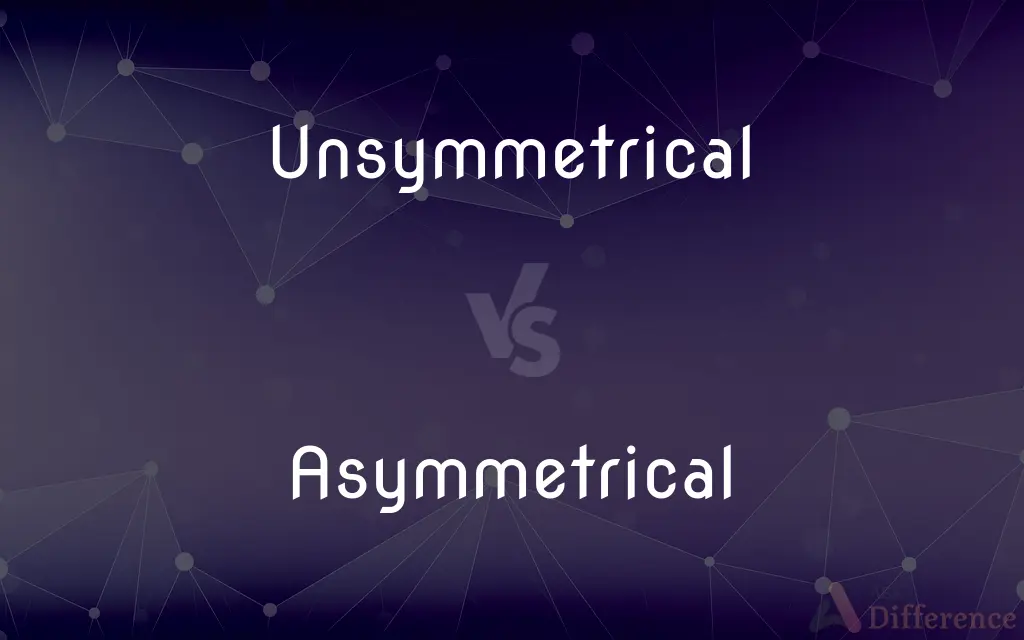Unsymmetrical vs. Asymmetrical — What's the Difference?
By Maham Liaqat & Urooj Arif — Updated on March 12, 2024
Unsymmetrical implies a lack of symmetry in a broad sense, often in abstract or mathematical contexts, whereas asymmetrical specifically denotes an absence of mirror symmetry, commonly used in design and aesthetics.

Difference Between Unsymmetrical and Asymmetrical
Table of Contents
ADVERTISEMENT
Key Differences
Unsymmetrical is a term that describes a general deviation from symmetry, without specifying the nature of the imbalance. It can be applied to various contexts, including mathematics, where it may refer to unequal distribution or arrangement that doesn't follow a predictable pattern. Asymmetrical, on the other hand, specifically refers to the absence of mirror symmetry, where two halves of an object or design do not match when divided along a central axis. This term is widely used in art, architecture, and fashion, where such a lack of symmetry can be a deliberate stylistic choice.
In mathematical or scientific contexts, unsymmetrical often describes molecules or structures where elements are not arranged in a symmetrical fashion, affecting their properties and behaviors. Asymmetrical is used more in physical and biological sciences to describe organisms or structures that lack bilateral or mirror symmetry, an attribute that can have significant implications for function and evolution.
The aesthetic implications of asymmetry are particularly notable in visual arts and design, where asymmetrical balance is a key principle. This involves arranging non-identical elements in a way that creates balance and visual interest without mirroring. Unsymmetrical, while it can apply to aesthetic contexts, is less commonly used in this sense and carries a more neutral or technical connotation.
Despite these differences, the terms can sometimes be used interchangeably in casual conversation. However, choosing one over the other can convey more precise information about the nature of the imbalance or the speaker's perspective on symmetry.
Both terms enrich the English language, offering nuanced ways to discuss balance, design, and structure. Their use highlights the complexity and variability of symmetry in both natural and human-made contexts, from the molecular level to large-scale architectural designs.
ADVERTISEMENT
Comparison Chart
Definition
Lacking symmetry in a general or abstract sense.
Specifically lacking mirror symmetry.
Common Usage
More abstract or technical contexts, such as mathematics.
Widely used in design, art, and biology to describe non-mirrored arrangements.
Implication
Can imply a broader range of deviations from symmetry.
Implies a deliberate or natural deviation from mirror symmetry.
Aesthetic Application
Less commonly applied to aesthetic considerations.
Central to discussions of balance and aesthetics in visual arts.
Scientific Context
Used to describe molecules or structures without specific symmetrical arrangement.
Often refers to living organisms or physical structures lacking bilateral symmetry.
Compare with Definitions
Unsymmetrical
Not symmetric in arrangement or form.
The unsymmetrical layout of the garden added a unique charm.
Asymmetrical
Without mirror symmetry; not divisible into symmetrical halves.
The artist's use of asymmetrical balance in the painting captivated viewers.
Unsymmetrical
Not adhering to a predictable or regular pattern.
The unsymmetrical design of the quilt made it visually interesting.
Asymmetrical
In biology, referring to organisms without bilateral symmetry.
Asymmetrical flowers often attract specific pollinators.
Unsymmetrical
Lacking equality or uniformity in distribution.
The plot of data points was unsymmetrical, indicating a variance in the results.
Asymmetrical
Employed in fashion to describe uneven or non-identical designs.
Her asymmetrical dress was the highlight of the fashion show.
Unsymmetrical
Can describe abstract concepts or patterns.
The argument presented was unsymmetrical, lacking balance in perspectives.
Asymmetrical
Creating visual interest through imbalance in design.
Asymmetrical page layouts can make websites more engaging.
Unsymmetrical
Applied to molecules with uneven distribution of atoms.
Unsymmetrical ethers have different alkyl groups attached to the oxygen atom.
Asymmetrical
Used in architecture to create dynamic and interesting spaces.
The asymmetrical building stood out against the city's skyline.
Unsymmetrical
Another term for asymmetrical
Asymmetrical
Having no balance or symmetry
An asymmetric design.
Unsymmetrical
Asymmetric.
Asymmetrical
Uneven in distribution.
Unsymmetrical
Not symmetrical.
Asymmetrical
Existing or occurring between two incommensurate entities, especially to the detriment of one.
Unsymmetrical
Wanting in symmetry, or due proportion pf parts.
Asymmetrical
Characterized by an imbalance in power between two opponents in an armed conflict, especially one in which a weaker force uses unconventional means, such as guerilla or terrorist tactics
Asymmetric warfare.
Unsymmetrical
Not symmetrical; being without symmetry, as the parts of a flower when similar parts are of different size and shape, or when the parts of successive circles differ in number. See Symmetry.
Asymmetrical
(Chemistry) Of or relating to a carbon atom having four different atoms or structural groups attached to it, resulting in an unbalanced spatial arrangement of atoms in a molecule, so that the molecule cannot be superimposed on its mirror image; chiral.
Unsymmetrical
Being without symmetry of chemical structure or relation; as, an unsymmetrical carbon atom.
Asymmetrical
Not symmetrical.
Unsymmetrical
Lacking symmetry
Asymmetrical
(of a question) Presenting a false dilemma, or a choice between two things which are not opposites.
Unsymmetrical
Having unsymmetrical parts or unequal dimensions or measurements
Asymmetrical
Characterized by asymmetry in the spatial arrangement or placement of parts or components
Asymmetrical
Irregular in shape or outline;
Asymmetrical features
A dress with an crooked hemline
Common Curiosities
Can unsymmetrical and asymmetrical be used interchangeably?
In casual conversation, perhaps, but choosing one over the other can provide clearer communication of the intended meaning, especially in technical contexts.
Are unsymmetrical molecules common in chemistry?
Yes, unsymmetrical molecules are quite common and can have different properties from their symmetrical counterparts, affecting their reactions and applications.
What is the main difference between unsymmetrical and asymmetrical?
Unsymmetrical broadly denotes any deviation from symmetry, while asymmetrical specifically refers to the lack of mirror symmetry.
Is asymmetry valued in nature?
Yes, asymmetry can play a crucial role in the function and evolution of organisms, from asymmetrical flowers adapted to specific pollinators to the asymmetrical arrangement of human internal organs.
What role does asymmetry play in fashion design?
Asymmetry in fashion introduces a unique and dynamic element to garments, often used to draw attention, enhance body lines, or break conventional style norms for a distinctive look.
How do unsymmetrical and asymmetrical apply to art?
While both can describe deviations from symmetry, asymmetrical is more commonly used in art to discuss deliberate choices that create balance and interest without mirror symmetry.
Why might a designer choose an asymmetrical approach?
Asymmetrical designs can add visual interest, dynamism, and balance without relying on mirror symmetry, making a space or object more engaging and visually appealing.
Can an asymmetrical design be balanced?
Absolutely. Asymmetrical balance is a fundamental design principle where different elements are arranged to achieve visual balance, despite not being identical on either side of an axis. This approach can make designs more lively and interesting.
Does the concept of unsymmetrical apply to mathematics?
Yes, in mathematics, unsymmetrical can refer to shapes, figures, or equations that do not exhibit symmetry, affecting their properties and solutions.
Can asymmetry be found in music?
Yes, asymmetry in music can refer to irregular rhythms, unbalanced harmonies, or compositions that defy traditional forms, often resulting in more complex and intriguing auditory experiences.
Is there a preference for symmetry or asymmetry in human attraction?
Research suggests that humans often prefer symmetrical faces in terms of physical attraction, associating it with health and genetic quality. However, in art and design, asymmetry can be equally or more appealing for its complexity and uniqueness.
Why might a garden designer use unsymmetrical elements?
An unsymmetrical garden design can create a more natural, spontaneous look, offering visual surprises and a less formal structure, which can be more engaging and relaxing for the observer.
How is asymmetry utilized in architecture?
Architects use asymmetry to create engaging and visually stimulating structures. It allows for innovative designs that can adapt to irregular land shapes, functional requirements, and aesthetic goals, making buildings stand out.
Are there any advantages to unsymmetrical designs?
Unsymmetrical designs can offer flexibility and creativity in solving spatial, functional, or aesthetic challenges, allowing for more personalized and innovative solutions that symmetrical designs might limit.
What implications does asymmetry have in biology?
Asymmetry in biology, such as in the arrangement of internal organs or the structure of certain organisms, can have significant implications for function, survival, and evolutionary advantages.
How do cultural perceptions of symmetry and asymmetry differ?
Cultural perceptions can vary widely; some cultures deeply value symmetry for its association with balance, harmony, and beauty, while others appreciate asymmetry for its representation of authenticity, dynamism, and innovation.
Share Your Discovery

Previous Comparison
Season vs. Climate
Next Comparison
Babu vs. BabyAuthor Spotlight
Written by
Maham LiaqatCo-written by
Urooj ArifUrooj is a skilled content writer at Ask Difference, known for her exceptional ability to simplify complex topics into engaging and informative content. With a passion for research and a flair for clear, concise writing, she consistently delivers articles that resonate with our diverse audience.














































